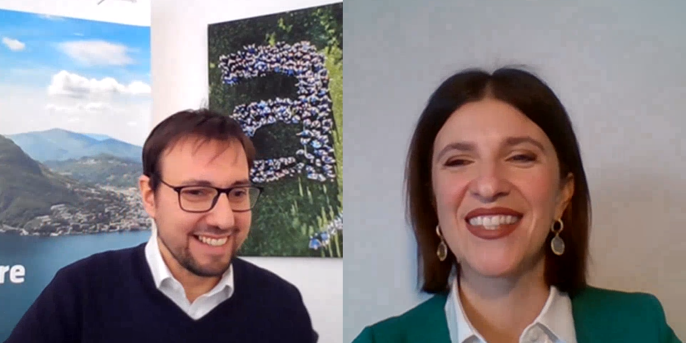7. April 2022 By Alessandro Tortelli and Chiara Gelmini
A conversation with Chiara Gelmini from Pega

Alessandro Tortelli (adesso Schweiz AG) with Chiara Gelmini (Pega)
Hint: Scroll down if you want to watch the full interview as a video.
Alessandro Tortelli: What is the value proposition of Pega, and what are the customer pain points it addresses?
Chiara Gelmini: Dealing with high business complexity? People and resource intensive business? High process volumes? Highly regulated industry? This is what Pegasystems Inc. (Pega) is for.
Because we help organizations transform how they engage with their customers and process work, with Pega enterprises not only get work done, but more importantly make better decisions.
Thanks to our scalable architecture and low-code/no-code platform, even the biggest organizations can stay streamlined, agile, and ready for what's next. Pega's cloud-architected portfolio of applications leverages artificial intelligence (“AI”), case management, and robotic automation technology, built on the truly unified low-code Pega Platform™, empowering businesses to quickly design, extend, and scale their enterprise strategic applications to meet sophisticated business needs.
All of this is foundational to customer risk solutions that Pega supplies to the world’s largest organizations for over 15 years now, spanning from client and account opening, client lifecycle management, KYC, AML and fraud alert management, lending, and payments.
In a world of endless discussions between ‘buy’ or ‘build’ strategies, Pega plays agnostic. We cater both to the companies that opt for a build strategy which would use the Pega Platform™ as low-code application factory, and to those who are looking for a robust built-out solution with key accelerators.
For instance, Pega CLM, which includes KYC due diligence workflows and out of the box regulatory rules for 60 jurisdictions, is Pega's strategic readily-available application covering Onboarding, Client Lifecycle Management, and KYC. Introduced back in 2008, it provides all types of financial institutions with pre-defined industry standards that we continue to innovate in line with industry needs and best practices, leveraging all of the functionality that Pega Platform has to offer.
Could you tell us a few details about the history of PEGA?
Chiara: Let me start with facts: Pega has a story of almost 40 years, founded in 1983 by our CEO Alan Trefler, and is publicly traded on the NASDAQ (PEGA) since 1996, headquartered in Cambridge (MA-US) with 40 locations across Asia, Europe, North America, and South America.
What I personally enjoy a lot of Pega though, is that we’re a different kind of tech company. It’s a global business rooted in family!
Did you know that Pega has the game of chess built in its DNA? Chess was great part of Alan’s family and his father taught it to him as a child. And kept on beating him at it... so Alan decided he needed to study it more: got a rulebook, practiced endless hours, eventually entered the World Open later on, and ended up tying for first in 1975! How does all of this ties into Pega? Well, interestingly enough, it got Alan’s into programming computers to play chess in college and the whole idea of trying to capture the way a chess master thought about a position. What if someone could take this thinking, and apply it to business problems? And further, what if this could be done in a non-super techie way, actually bringing business people involved in how their systems were built?
I also like a lot the story that goes with the choice of the name Pegasystems and its logo, which comes from the winged horse Pegasus. How cool it is for a passionate chess player to have a chess piece as a logo? But it gets even more interesting. In the ancient Greek mythology, Pegasus is born from Medusa’s blood as her head was lopped by Perseus. You might ask "what has this to do with Pega?". Well, when Alan founded Pega he was 27 years old, the company he was formerly employed with got acquired. He and his partners were disappointed in the way they were treated by the acquiring company, they felt they‘ve been sold out.
Like Pegasus, Pegasystems was a new life, a new way of working that Alan and his partners imagined for their future!
What were and are the critical challenges financial industry is facing?
There are three main strands of challenges that weighted on the financial services sector and continue to influence it, all of which root in the inherent complexity of the industry:
- I Compliance burden
- II Customers and business sophistication
- III Strategic workflows intricacy
I Compliance burden
No surprise to anyone: financial services are confronted with a composite regulatory environment, fragmented policy frameworks, new requirements every other day.
Couple this with older pieces of law making, with many grey areas making room for interpretations, and you have the perfect storm, exposing firms to fines and progressive cost of compliance, which impacts their cost-income-ratio, and hinders their business profitability.
So, the question is how to pivot regulatory compliance into a competitive advantage? How to standardize practices across geographies while ensuring compliance readiness, effectiveness, and resilience?
II Sophisticated customers and business
Financial businesses created complex, often manual and labor-intensive responses, to cater for an increasingly demanding clientele, characterized by sophisticated needs and goals, paving their way to heavy cost structure and high resource consumption.
III Strategic workflows intricacy
Heavy data gathering, and documents collection, disjointed actors and tasks, proliferating and siloes systems, duplicated and inconsistent data.
All of this leads to massive backlogs and workload peaks, long cycle times frequently made even more sloppy by manual and paper-based work.
How to remove front-to-back inefficiencies, while increasing risk management effectiveness?
How do you navigate these challenges?
Now imagine if you could address all these challenges by making your approach adaptive, compliant, flexible yet guided, composable and scalable! We observe some key sustained shifts happening across the B2B tech buyers’ community.
I would start with the quest for a unique case management tool, a unified orchestration layer on which many other pieces of software can be hung on to, that not only supports a holistic overview of clients and their related insights and activities, but also serves as a centralized risk management tool. No media break, no need to log in and out from multiple different systems. A tool that takes the complexity out of the clients’ and employees’ experience and
dynamically switches from injecting the maximum possible automation onto clerical tasks or high-volume activities, to allowing for collaborative, parallel working patterns suited to SME and ETP cases.
FinCrime and alert management is another ‘hot’ area with lots of movement. Banks are enhancing, or rethinking, their detection systems to be more AI/ML focused to. How to transform the triage process with a smart approach to alerts? How to streamline enterprise workflow, enrichment of data, and audit processes? How to improve outcomes with a holistic approach to case management while having less operational impact to the end users?
Another trend we see consistently is tech rationalization. The market is increasingly looking for the freedom to reuse pieces of technology across multiple client segments, jurisdictions, products, and departments. In our experience this is best achieved with enterprise, highly composable and therefore scalable architectures.
Finally, the shift towards adaptive compliance, one that’s data driven and agile with dynamic rules making it possible to perform the needed controls while responding to change in a fast and simplified manner.
What are the new challenges? And the solutions?
Todays’ customers, across segments and demographics, are different in nature.
They have zero-tolerance for slow, unresponsive, broken journeys and tools. They want to be in the driver seat, empowered to make decisions autonomously, or in collaboration with their financial firm of choice for complex needs, depending on what they consider most convenient. Most likely contact will happen only if customers demand it.
There’s no such a thing as ‘channel separation’ in their interactions. They seamlessly switch, or expect to do so, from Instagram, to an e-shop, to their favorite app, to a local store, and back again online.
While banks still build journeys siloed in one channel, forcing customers to use it regardless of what is truly convenient to them, or even worst, forcing customers out of the channel they chose, therefore breaking their experience.
In the next 3 to 5 years, leaders will enable frictionless, personal interactions, with near-invisible banking services, quick to adapt, with resilient and reliable operations.
Sustainability has already gained center stage in financial businesses agendas, and by 2023-4 clear and structured actions will be woven into their business as usual. Consumers spend analytics that flag your carbon footprint and suggest how to reduce it, know-your-customer (KYC) that include know-your-investment (KYI) for a sustainable investing practice, sustainable lending, spotting, assessing and addressing ESG-related risks… these are only few of the shifts we will (and are) witness.
We see massive opportunities for increasing efficiency, timeliness and relevance when combining these shifts with technology.
What is your vision of the future for PEGA?
Since its inception, Pega is passionate about helping organizations transform how they engage with their customers and process work, by building a scalable architecture based on low-code AI-infused platform to stay ahead of rapid change.
Pega’s strategy for the future is to continue providing products and services that enable organizations to become agile and efficient digital enterprises. We have created and will continue to maintain and follow through on the vision of a multitude of strong business capabilities being made available on a single unified technology platform that is business friendly and intuitive.
If we take a look to some of the most critical and complex workflows such as Onboarding, KYC, Lending and Credit Decisioning, FinCrime and Case Management, there’s three great opportunities leaders won’t want to miss:
- 1) Simplified yet Effective Compliance: flexible, collaborative and contextual, while at the same time faster and simplified compliance, that relies on intelligent automation, a single robust case management layer, and AI to make compliance and risk management teams’ life easier with improved investigative risk decisioning and better operational efficiency.
- 2) Personal at Scale: living by the ‘KYC’ rule, means not only assess what risks may hide with your customers, but more importantly what opportunities may arise. Be personal to your customer, relevant, timely, across all channels, touchpoints, and lines of business.
- 3) Functional Scalability: there’s repeatable patterns across the key activities underlying to complex workflows across the client lifecycle: collecting information, enriching and verifying this data, assess them and take decision, finally activating them. Huge opportunities lie in the ability of recombining and reusing readily available digital capabilities to address such common patterns across: teams and groups, jurisdictions, and lines of business to truly enable functional scalability and tech rationalization.
In addition to the investment in the core Pega Infinity Platform, Pega will continue to evolve its strategic applications for Marketing, Sales and Onboarding, KYC, Customer Service, and Operations. These strategic horizontal applications are complemented by industry vertical variations, which embed leading practice functionalities directly into the application.
We also continue to focus on maintaining a lead in real-time customer engagement and intelligent automation through investments we have made in areas like channel independent integration (through DX API) and ease of build and change through our Application Studio.
Because ultimately our mission is to save people time, so our clients’ employees and customers can get back to what matters most. This remains our mantra, even more so amidst recent times.


